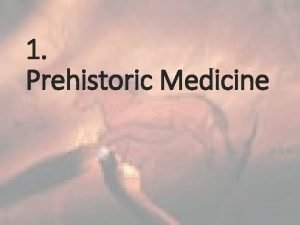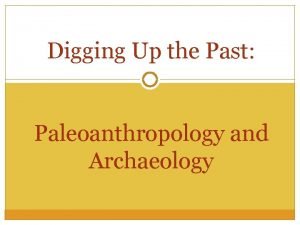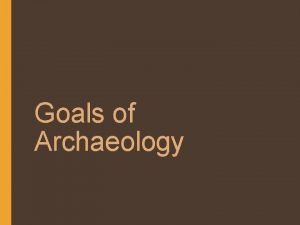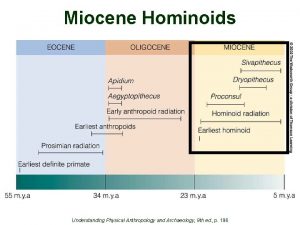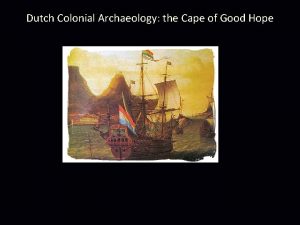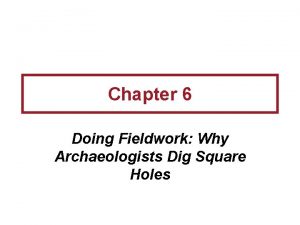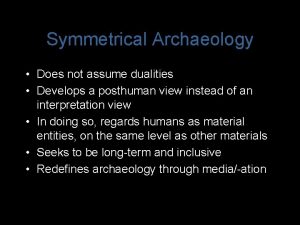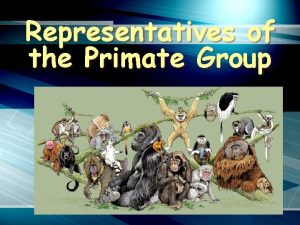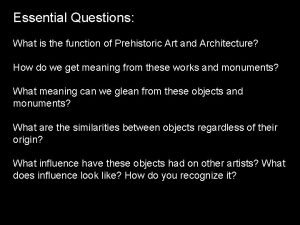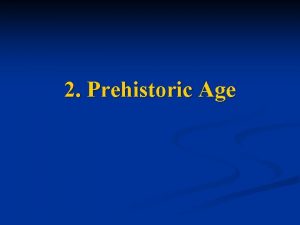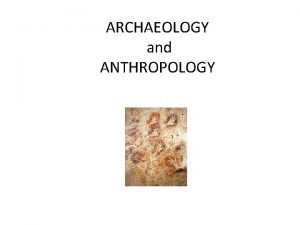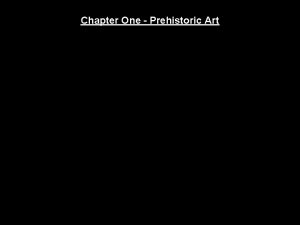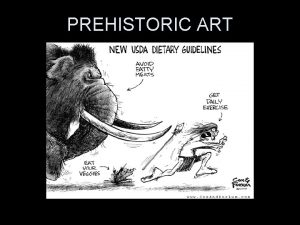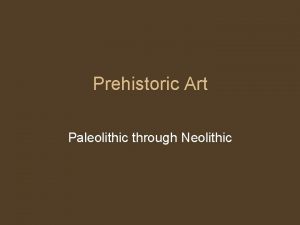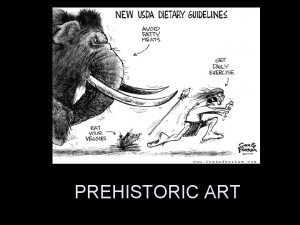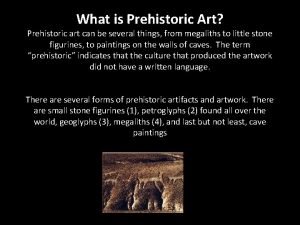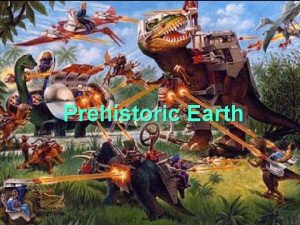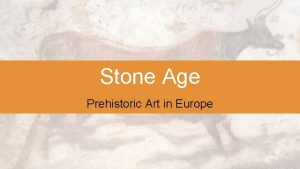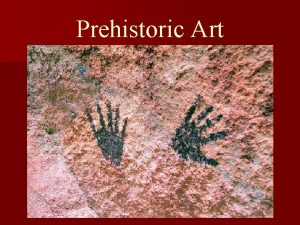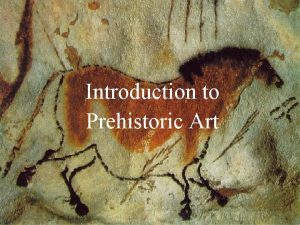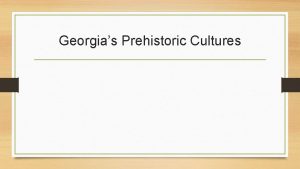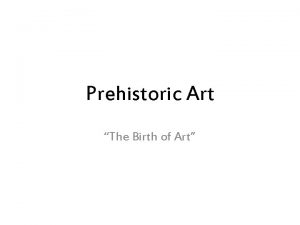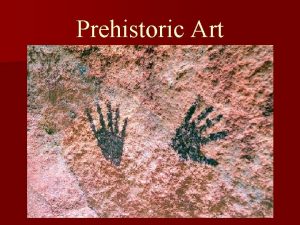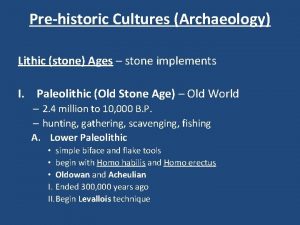Prehistoric People Archaeology Europeans found that they could
























- Slides: 24

Prehistoric People

Archaeology � Europeans found that they could learn from artefacts how people lived long ago. � Artefacts were not always works of art they were tools, pottery, and weapons. Anything made by prehistoric people. � People started to practice archaeology about 500 years ago. � Archaeology is the study of the remains of past human life and cultures. � People who lived in ancient times didn’t leave many written records or any at all. � Many important Archaeological discoveries have been made over the centuries. For example, in the year 1700 some Italian farmers discovered they were living on top of an ancient roman city named (Herculaneum).

Dating Archaeological Remains � In 1983 J. Thomsen, an archaeologist, divided human history into 3 parts. � Thomsen named the ages the Stone age, the Bronze age and the Iron age. � These ages were based on the material people used for making tools and weapons during them. � Scientist relied on common sense when unearthing artefacts.

Prehistoric People � They originated in Africa. � They lived on the grasslands of the Southern and Eastern parts of Africa. � It became colder � People were able to migrate � Between 1. 75 million and 700, 000 years ago people made their way into Europe and Asia � The sea level fell and uncovered land � Land bridges connected Africa to Europe and Asia

Obtaining Food � Palaeolithic people lived in small � � � groups of about 30 members. When the food supply was good the bands grew to about 40 to 50 members. Woman and children gathered berries, nuts, fruit and eggs out of bird and turtle nests. They poked sticks into bee`s nest to get honey and into the ground to dig roots. They caught fish using their bare hands and hunted small animals with sticks and stones. For more than 2 million years, prehistoric people lived by hunting animals and gathering plants.

Prehistoric Bands of People • • • Most group members lived to be no more than 20 or 25 years old. They fed and cared for people who became injured or sick. The band stayed at a campsite until the available food supply was used and then moved. Each band searched for food within an area known as its home territory. A good kill meant that the group would have enough meat to last for several days.

Shelter � Prehistoric people usually camped out in the open. � They dug pits to live in or they crouched in dry river beds. � They also took shelter under an overhanging rock or piled up brush. � At first people only used caves for emergencies such as sudden storms or to hide from large animals. � About 100 000 years ago people in China, Western Europe, and South Western Asia were living in caves for most of the time.

Making Clothing � Hunters killed large animals. � Animal skins were used for warmth and protection. � To make the hides softer they scraped and cleaned them and then put them out in the sun. � Later people discovered that putting fat into the skin would also make it softer. � Clothing made a big difference in where people lived. Warmer clothing meant that prehistoric people could live in colder climates.

Making Tools and Fire � The people of the Palaeolithic Age first discovered fire from nature (lighting, forest fires for example). � The people also used it to cook food. As a result it was easier to chew and digest. � They also used fire to clear bushes and undergrowth. � They used it to keep themselves dry and warm. � They also used it as weapon, (throwing burning sticks at animals and trespassers).

Developing Language �Before the early people learned to talk, they simply made sounds or pointed. �They used hand signals for common things such as water, food, animals, and weapons. �Because of new social needs sound and hand signals were no longer enough. �The developing of language was a great human achievement. �It made it possible for people to work together, share ideas, and share their stories.

Neanderthals � The first discovery of Neanderthal � � remains were made in Germany in 1856. Neanderthals were good hunters. They used traps to catch birds and other small animals. They used pitfalls to catch elephants and rhinoceros. A pitfall is a large hole with leaves and branches covering it that the animal would fall into. Neanderthals built houses with mammoth bones and animal skins. Thirty people could live in the house together. According to experts they were the first people to bury their dead.

Cro-Magnons � Archaeologists consider Cro-Magnons to be the first modern people. � Cro-Magnons were very skilful toolmakers. � They invented the burin, which resembles a chisel. � The burin allowed them to make other tools out of antler, bone, ivory, shell, stone and wood. � Cro-Magnon people made canoes out of logs which allowed them to travel on water.

Cro-Magnons Artistry �They were artists as well as tool makers. �They also made jewellery out of bone and ivory as well as flutes out of hollow bone. �Cro-Magnons painted pictures using minerals.

The Cro Magnons • The tools made the Cro-Magnons better hunters. • Tools also increased their food supply. • They improved their tools to make them more useful so they could go faster and farther with them. • One example of an advanced tool is the axe. • These improvements made working with these tools less dangerous.

The Cro-Magnons � Cro-Magnon belief systems and ways of doing things evolved over time. � Anthropologists think cave paintings have religious significance. � Painting the animal would give them power to fight and kill. � Their paintings told stories about their ceremonies and traditions. � Cro-Magnon people engaged in early commerce. They traded materials like amber and shells. � Cro-Magnons They also communicated with others about the movement of animal herds.

The Neolithic Age � People changed from food gatherers to find producers. � They obtain most of their food from farmers. � This brought a lot of changes in the life of the Neolithic Age. � Then the Neolithic revolution came. � They learned to herd animals and grew food.

Gathering Food � They could plant seeds that they found such as wheat and barley � They also grew corn, squash, and potatoes � This was noticed when there were spilled � Scientists believed that agree culture developed independently in different parts of the world � South-western Asia , early people grew wheat and barley

The Food Supply �The hunters killed one animal at a time saving the rest for later. �People also began using certain animals such as donkeys, camel and llamas. �Within 4000 years the population grew about 90 million. �The experts think there were about 5 million people in 8000 B. C. �The Neolithic revolution greatly increased people’s food supplies.

Early Villages � Prehistoric people built permanent � � � shelters of about 150 -200 people. They built shelters in areas with good water and soil supply. The earliest known villages in the world were found in south western Asia. For protection against attack, people in early villages, had no doors or windows. People had a hole in roofs of their house as their only entrance. Prehistoric people did not have much, so they covered their floors of their houses with grass plants.

Early Villages �They covered their sleeping platforms with mats. �Around the houses there were courtyards with large ovens for baking bread. � Beyond the houses were vegetable gardens. �They also had apple orchards and grain fields. � They had sheep and cattle that grazed in the pasture. � One of the oldest village is Jericho.

Specialization, and religion � People learned to weave cloth from wool. � People also learned to make pottery by baking clay. � People lives depended on the use of a given piece of land. � Experts believe that the chiefs of most Neolithic villages were also priests. � At first Neolithic people prayed to the forces of nature that they saw around them.

Prehistoric Jobs � People started doing jobs that didn’t produce food because of increased food supplies. � A village chief was chosen to settle disputes over land ownership. � It is believed that most chiefs were also priests. � People created gods and goddesses to explain the forces of nature. � They picked up lumps of copper, lead, gold , and silver of the ground. � They dyed cloth bright colors and used it for clothing. � People had to protect their own land in order to keep it.

Prehistoric presentation key ideas � During the Palaeolithic age prehistoric people lived in small hunting and food gathering bands. � Over time Palaeolithic learned to make tools, clothes, developed language, and discovered how to make fire. � Food production made it possible to settle in one place. � Increased food supplies in the Neolithic Age resulted in increased population and specialisation. � Neolithic villagers learned to make pottery, weave on looms, and work with metals. � Neolithic village government was led by a chief who settled disputes and directed village activities.

The End Thank-you for watching!
 The medicine of prehistoric people
The medicine of prehistoric people Thơ thất ngôn tứ tuyệt đường luật
Thơ thất ngôn tứ tuyệt đường luật Tôn thất thuyết là ai
Tôn thất thuyết là ai Phân độ lown ngoại tâm thu
Phân độ lown ngoại tâm thu Walmart thất bại ở nhật
Walmart thất bại ở nhật Gây tê cơ vuông thắt lưng
Gây tê cơ vuông thắt lưng Block nhĩ thất cao độ
Block nhĩ thất cao độ Tìm vết của đường thẳng
Tìm vết của đường thẳng Sau thất bại ở hồ điển triệt
Sau thất bại ở hồ điển triệt Thể thơ truyền thống
Thể thơ truyền thống Hãy nói thật ít để làm được nhiều
Hãy nói thật ít để làm được nhiều Archaeology
Archaeology Goals of archaeology
Goals of archaeology Pliopithecus
Pliopithecus Dr john oakes
Dr john oakes Archaeology
Archaeology Arbitrary vs natural levels archaeology
Arbitrary vs natural levels archaeology Archaeology is a messy business
Archaeology is a messy business Symmetrical archaeology
Symmetrical archaeology Ancient art 1 500 00 bc-2 000bc
Ancient art 1 500 00 bc-2 000bc Georgia's prehistoric cultures chart
Georgia's prehistoric cultures chart Q
Q What is the function of prehistoric painting
What is the function of prehistoric painting Prehistoric monument dan word
Prehistoric monument dan word Cave art definition
Cave art definition
